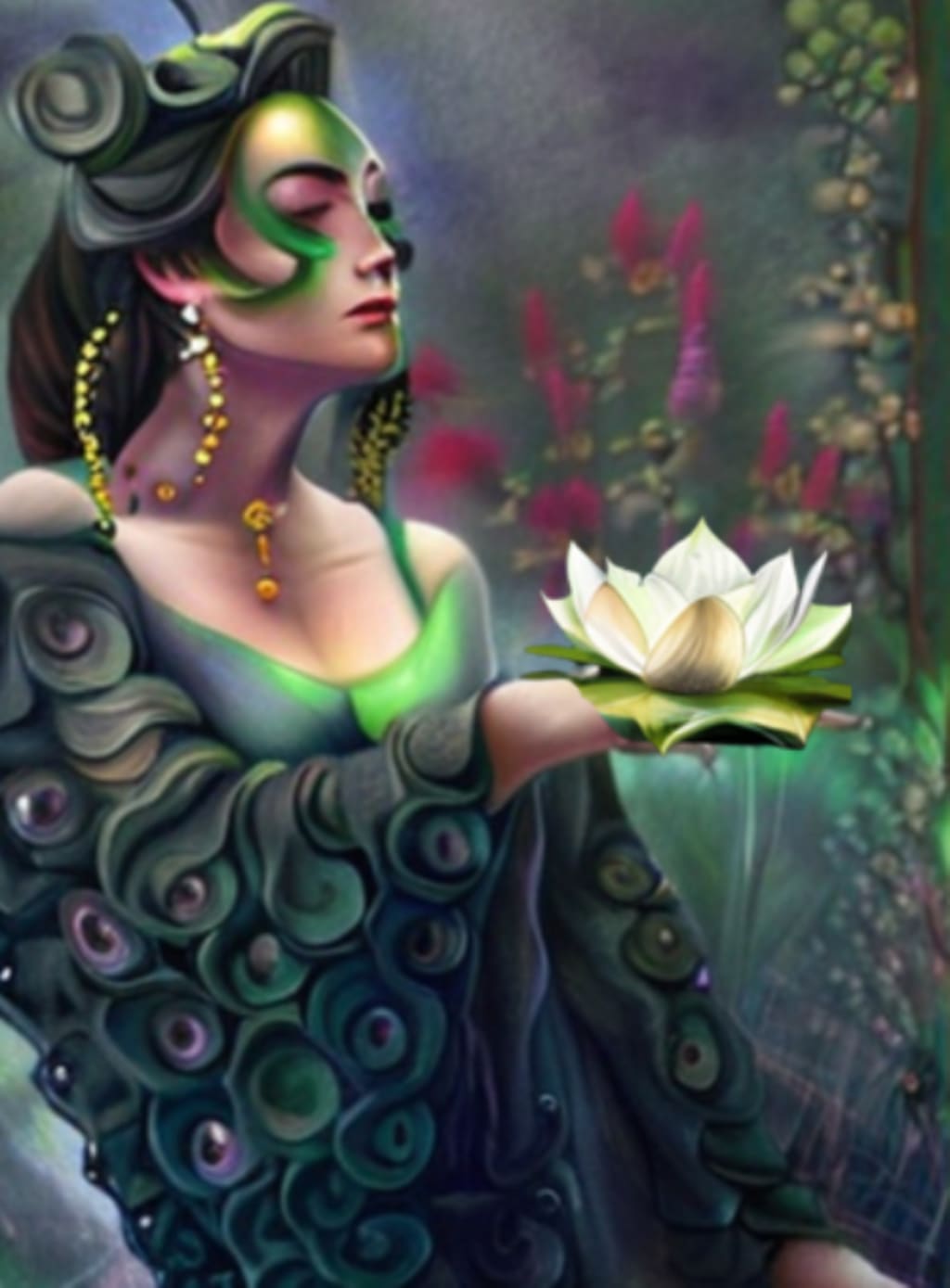The Origins and Symbolism of Green Tara in Tibetan Buddhism
Read this article to learn more about Green Tara

Intro
Green Tara is an important goddess in Tibetan Buddhism, dating back to the 7th century. She is a female bodhisattva associated with compassion, action, and enlightened activity. She is often portrayed in art as seated on a lotus throne, with her right foot poised and ready to take action. Green Tara is seen as a protector and a symbol of spiritual attainment, and her popularity has endured throughout centuries of the Tibetan Buddhist tradition. In this blog post, we'll explore the origins and symbolism of Green Tara in Tibetan Buddhism.
The Origins of Green Tara
Green Tara is a goddess revered in Tibetan Buddhism as a compassionate figure who protects beings from all types of fear and harm. The origin of Green Tara can be traced back to ancient Indian and Hindu mythology, where she was known as Tara, the mother goddess. It is believed that Tara was a goddess of many forms, including White Tara, who represents peace and compassion.
In the story of Green Tara, she is said to have been born from a single tear of Avalokitesvara, the bodhisattva of compassion. This tear landed on a lotus flower, and from it, Green Tara emerged. Green Tara embodies the swift and immediate action of compassion, and her green color symbolizes her activity and connection to the natural world.
The Green Tara mantra, "Om Tare Tuttare Ture Soha," is a powerful mantra in Tibetan Buddhism that invokes her presence and protection. The Veil of Protection prayer, or Green Tara prayer, is also used to connect with Green Tara and ask for her assistance in removing obstacles and fear.
Today, Green Tara remains an important figure in Tibetan Buddhism, and her compassionate energy is invoked through meditation, mantras, and visualizations to support individuals in their spiritual journey.
The Symbolism of Green Tara
Green Tara is a symbol of enlightenment and compassion in Tibetan Buddhism. Her color, green, represents the vitality and liveliness of a flourishing forest, signifying the flourishing of spiritual awakening. Tara, on the other hand, means “star” or “guide” in Sanskrit. As the goddess of compassionate action, she is regarded as a swift and decisive savior, known for rescuing those in need from harm and protecting them from negative forces.
Green Tara is also portrayed as having one leg crossed over the other, signifying her constant readiness to act on behalf of sentient beings. She has an extended hand in a gesture of fearlessness, indicating her willingness to protect and alleviate the fears of all beings. The other hand is in the boon-granting gesture, symbolizing her willingness to fulfill all wishes and help practitioners attain spiritual realization.
Moreover, the seven eyes on Green Tara's face, hands, and feet are symbolic of her ability to perceive all forms of suffering and to manifest various skillful means to alleviate such suffering. Finally, the lotus flower on which she sits represents her freedom from worldly afflictions and limitations. Therefore, by understanding and connecting with the meaning and symbolism of Green Tara, Tibetan Buddhists can achieve spiritual progress and overcome their limitations and suffering.
How to Connect with Green Tara in Practice
To connect with Green Tara in practice, one must first understand her meaning and significance. Green Tara is known as the "Mother of All Buddhas" and is revered as a compassionate and nurturing deity in Tibetan Buddhism. She is believed to have the power to alleviate suffering and grant wishes.
To connect with Green Tara, one can start by creating an altar dedicated to her. Place a statue or image of Green Tara on the altar along with offerings such as flowers, incense, and water. Light a candle and offer prayers or mantras to Green Tara, asking for her guidance and blessings.
Another way to connect with Green Tara is through meditation. Sit in a quiet and peaceful place and visualize Green Tara's green radiant light surrounding you. Imagine her compassion and protection enveloping you, helping you to overcome obstacles and find inner peace.
Chanting the Green Tara mantra, "Om Tare Tuttare Ture Soha," is also a powerful practice to connect with her. Reciting this mantra helps to purify the mind and cultivate compassion.
Lastly, one can connect with Green Tara by studying and reflecting on her qualities and teachings. Explore her stories and myths, and learn from her wisdom and compassion.
By connecting with Green Tara in practice, one can tap into her transformative energy and find support on the spiritual path. Her presence and guidance can help to bring about healing, protection, and ultimately, liberation from suffering.
Stories and Myths of Green Tara
Green Tara is a deity that has been worshipped for centuries in Tibet. One of the most famous stories about Green Tara is that she was once a princess named Yeshe Dawa. She was known for her kindness and compassion and was able to cure people of their illnesses. When a group of monks visited her father, the king, she begged them to teach her the Dharma. They told her that she had to be reborn as a man to achieve enlightenment, so she made a vow to become a female bodhisattva instead.
Another story about Green Tara involves her rescuing a fisherman from drowning. The fisherman was caught in a storm on the sea and prayed to Tara for help. She appeared to him as a goddess and pulled him out of the water. From then on, the fisherman was a devout follower of Green Tara.
These stories and myths highlight the meaning and symbolism of Green Tara as a compassionate and protective deity who can offer guidance and support to those who seek her help. Her power to transform and save is still celebrated today in Tibetan Buddhism.
The Significance of Green Tara in Tibetan Buddhism Today
Green Tara holds great significance in Tibetan Buddhism today. She is considered a Bodhisattva, a compassionate being who embodies enlightenment and works for the benefit of all sentient beings. Green Tara is often seen as a female deity who symbolizes healing, protection, and liberation.
Her green color represents the energy of growth, rejuvenation, and transformation. As a figure of compassion and wisdom, Green Tara is believed to help individuals overcome fear, obstacles, and negative emotions. Many Buddhists turn to her for guidance and support in their spiritual journeys.
The meaning of Green Tara goes beyond her symbolism and extends into practical aspects of Tibetan Buddhism. Devotees often recite her mantra, "Om Tare Tuttare Ture Soha," which is believed to invoke her presence and blessings. Meditating on Green Tara is believed to cultivate qualities such as compassion, wisdom, and fearlessness.
In Tibetan Buddhist rituals and ceremonies, Green Tara is invoked for protection and to remove obstacles. Her image is often displayed in homes, temples, and monasteries, serving as a reminder of the enlightened qualities she embodies.
In essence, Green Tara's significance lies in her role as a compassionate and wise guide in Tibetan Buddhism. She is a source of inspiration and empowerment, providing solace and assistance to those who seek her support in their spiritual practice.
Experience Green Tara for yourself as she works within your energy field to open your heart. Click Here Now.
About the Creator
Isabella Hope Jewell
I am an Indigo Angel who has come to seed Light onto the planet and to Illuminate the Shadow Self within to assist in your ascension journey.
I channel Sacred Angelic Frequencies for your healing, alignment, and ascension.






Comments
There are no comments for this story
Be the first to respond and start the conversation.